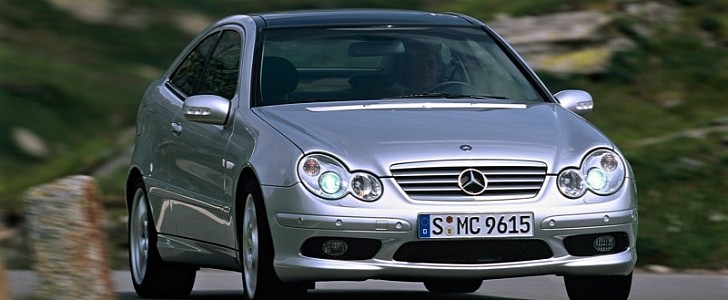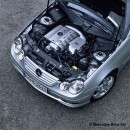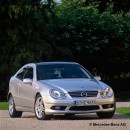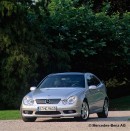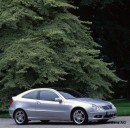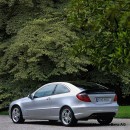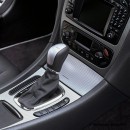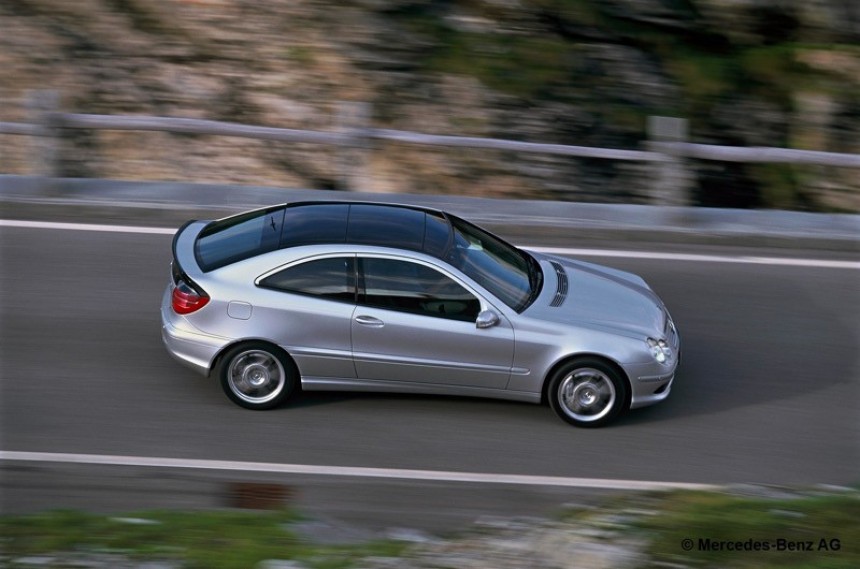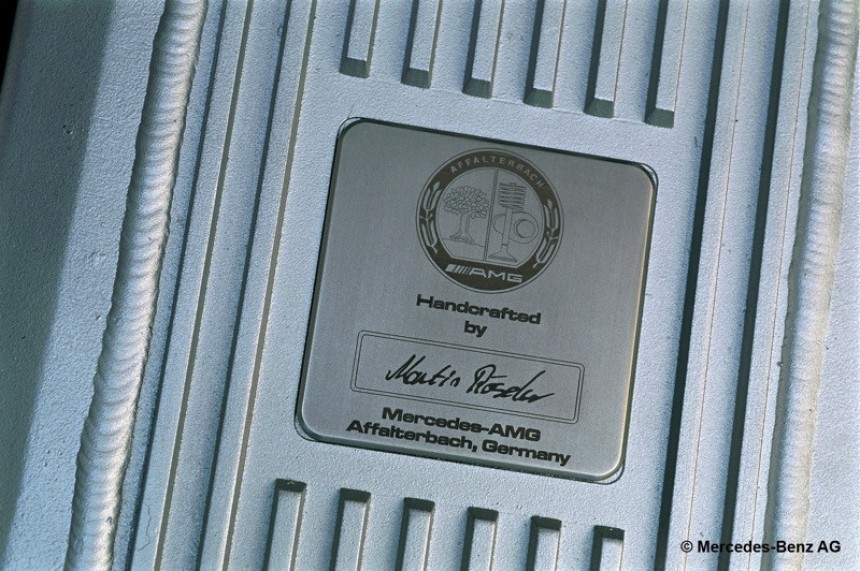Believe it or not, almost 20 years ago, there was a time in history when the folks at AMG headquarters imagined building a diesel sports car. Combining chassis bits from the C 32 AMG and adding an upgraded heart from a Sprinter commercial van, the C 30 AMG CDI turned out to be quite an agile machine.
In the modern-day era, a diesel high-performance vehicle is not something unheard of. You just need to take a look at the recent Audi S line-up for the European market like the S4 or S6 or at the monster quad-turbo engines of BMW's M50d variants to convince yourself that there is something going for the oil-burners.
But back then, in 2003, even if the market was utterly in love with diesel technology, the idea of a sports car powered by tractor fuel was genuinely crazy. And who could prove them wrong other than AMG?
This kind of outside-the-box thinking is profoundly engraved in the German brand's DNA. At the time, they were still trying to establish themselves as a proper high-performance vehicle manufacturer. Such engineering endeavors propelled them to the breaking news section of the automotive industry and made quite a stir inside petrolheads' minds.
In the early 2000s, diesel was the golden ticket: low fuel consumption, more robust engines, high levels of torque output, and low CO2 emissions. So, when we think of performance diesels from that time, Audi's prototype Le Mans racers come to mind, which sparked the creation of the 6.0 V12 TDI Q7, or its little brother, the Touareg V10 5.0 TDI.
But, many years before all of this engineering "flexing," Mercedes-Benz (MB) tested the waters, engaging its performance brand, AMG, to develop a sports car, only there was a catch. Maintain the one man one engine consecrated philosophy, but put to good use the dark fuel, leaving aside their love for petrol for this project.
This experimental endeavor resulted in the C 30 AMG CDI, a vehicle that could be ordered in coupe, saloon, or wagon form. For starters, CDI stands for common rail diesel injection, a direct injection type of fuel delivery.
At the heart of this unusual AMG-badged machine was a surprising powerplant. It was a derivative of the OM612 diesel inline-five engine, which at the time went on sale on the European market and powered models such as the C-, E-, or ML-Class, as well as the Sprinter commercial vehicle. But make no mistake, the technicians at AMG fiddled with this engine quite a bit.
They did their magic by increasing its displacement from its original 2.7 to 3.0 liters and using double-overhead-cam and 20-valve technologies. As a result, the engine saw a power rating of 228 hp from its stock 168 hp and a more impressive rise in torque values from 270 lb-ft (366 Nm) to 398 lb-ft (539 Nm). It came mated to a 5-speed automatic transmission with manual shifting capability, and the engine output was delivered to the rear wheels only.
This tuning effort meant good acceleration times, especially for a diesel, but not so impressive compared with other performance machines such as the bigger brother, the C 32 AMG, or other rivals such as BMW M3 or Audi S4. From a standstill, it could reach 62 mph (100 kph) in 6.8 seconds and hit a limited top speed of 155 mph (250 kph). These numbers were not helped by the vehicle's hefty curb and gross weight of about 3615 lbs (1640 kg) and 4618 lbs (2095 kg), respectively.
Conversely, overlooking acceleration times, the C 30 AMG CDI was a fuel-economy champion compared to the other gas-guzzling fast sedans. It could average up to 31 mpg (9.1 l/100 km).
The large majority of the chassis elements were shared with its gasoline counterpart, the C 32 AMG powered by the 3.2-liter V6 Kompressor engine.
The suspension system was a three-link in the back and multilink in the front assembly, associated with coil springs and torsion bar stabilizers. Stopping power came from a hydraulic dual-circuit braking system with a vacuum booster coupled with internally ventilated all-round brake discs, perforated in the front. Not least, the C30 came fitted with 17-inch light-alloy wheels covered in high-performance 225/45 front and 245/40 rear section tires.
Unfortunately, the C 30 AMG CDI did not enjoy high sales figures, being ordered in only 691 units, a consequence of several factors. Pricing was one of them, with the base configuration starting from €45,240 in 2003, meaning about €60,000 ($71,000) in today's money. In addition, other optional extras such as leather seats or a CD changer came at a steep cost, adding it all to large numbers and losing against nearly priced and more potent gasoline alternatives.
Even more unfavorable, in that period, Mercedes-Benz was not selling any diesel-powered passenger vehicles in the United States, meaning a large part of the market was closed from the start when it came to selling the C 30 AMG.
Sales being unexpectedly low, MB finally decided to halt the C 30 AMG CDI production in 2004. Furthermore, the C 32 V6 Kompressor evolved into the famous C 55 5.4-liter V8 simultaneously, meaning that petrol power regained the main focus of AMG engineers.
Since these events, AMG has never built another diesel car, so that brief period remains in history as the only time the Affalterbach-based brand ever offered a mass-produced oil-burner variant in their high-performance vehicle line-up.
But back then, in 2003, even if the market was utterly in love with diesel technology, the idea of a sports car powered by tractor fuel was genuinely crazy. And who could prove them wrong other than AMG?
This kind of outside-the-box thinking is profoundly engraved in the German brand's DNA. At the time, they were still trying to establish themselves as a proper high-performance vehicle manufacturer. Such engineering endeavors propelled them to the breaking news section of the automotive industry and made quite a stir inside petrolheads' minds.
In the early 2000s, diesel was the golden ticket: low fuel consumption, more robust engines, high levels of torque output, and low CO2 emissions. So, when we think of performance diesels from that time, Audi's prototype Le Mans racers come to mind, which sparked the creation of the 6.0 V12 TDI Q7, or its little brother, the Touareg V10 5.0 TDI.
This experimental endeavor resulted in the C 30 AMG CDI, a vehicle that could be ordered in coupe, saloon, or wagon form. For starters, CDI stands for common rail diesel injection, a direct injection type of fuel delivery.
At the heart of this unusual AMG-badged machine was a surprising powerplant. It was a derivative of the OM612 diesel inline-five engine, which at the time went on sale on the European market and powered models such as the C-, E-, or ML-Class, as well as the Sprinter commercial vehicle. But make no mistake, the technicians at AMG fiddled with this engine quite a bit.
They did their magic by increasing its displacement from its original 2.7 to 3.0 liters and using double-overhead-cam and 20-valve technologies. As a result, the engine saw a power rating of 228 hp from its stock 168 hp and a more impressive rise in torque values from 270 lb-ft (366 Nm) to 398 lb-ft (539 Nm). It came mated to a 5-speed automatic transmission with manual shifting capability, and the engine output was delivered to the rear wheels only.
Conversely, overlooking acceleration times, the C 30 AMG CDI was a fuel-economy champion compared to the other gas-guzzling fast sedans. It could average up to 31 mpg (9.1 l/100 km).
The large majority of the chassis elements were shared with its gasoline counterpart, the C 32 AMG powered by the 3.2-liter V6 Kompressor engine.
The suspension system was a three-link in the back and multilink in the front assembly, associated with coil springs and torsion bar stabilizers. Stopping power came from a hydraulic dual-circuit braking system with a vacuum booster coupled with internally ventilated all-round brake discs, perforated in the front. Not least, the C30 came fitted with 17-inch light-alloy wheels covered in high-performance 225/45 front and 245/40 rear section tires.
Even more unfavorable, in that period, Mercedes-Benz was not selling any diesel-powered passenger vehicles in the United States, meaning a large part of the market was closed from the start when it came to selling the C 30 AMG.
Sales being unexpectedly low, MB finally decided to halt the C 30 AMG CDI production in 2004. Furthermore, the C 32 V6 Kompressor evolved into the famous C 55 5.4-liter V8 simultaneously, meaning that petrol power regained the main focus of AMG engineers.
Since these events, AMG has never built another diesel car, so that brief period remains in history as the only time the Affalterbach-based brand ever offered a mass-produced oil-burner variant in their high-performance vehicle line-up.
